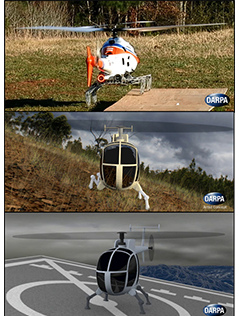 |
| September 22, 2015 | Volume 11 Issue 36 |
Designfax weekly eMagazine
Archives
Partners
Manufacturing Center
Product Spotlight
Modern Applications News
Metalworking Ideas For
Today's Job Shops
Tooling and Production
Strategies for large
metalworking plants
Wings:
DARPA gives sneak peek of adaptive robotic helicopter landing gear prototype
DARPA's automated folding legs adapt to angled, irregular, and moving surfaces.

Helicopters are incredibly maneuverable in the air, but during landing and takeoff their traditional skid- and wheel-based landing gear requires stable, flat surfaces -- surfaces that are often unavailable in helicopter-needy environs such as forward operating areas, ships at sea, and natural-disaster zones. Having the ability to land on and take off from angled, irregular, and moving surfaces would greatly expand the effectiveness of helicopters across many military and national security missions.
As part of its effort to provide such a breakthrough capability, the Defense Advanced Research Projects Agency (DARPA) has conducted an experimental demonstration of a novel robotic landing gear system. The adaptive system replaces standard landing gear with four articulated, jointed legs that are able to fold up next to the helicopter's fuselage while in flight and are equipped with force-sensitive contact sensors in their feet. During landing, each leg extends and uses its sensors to determine in real time the appropriate angle to assume to ensure that the helicopter stays level and to minimize any risk of the rotor touching the landing area.
"The equipment -- mounted on an otherwise unmodified, unmanned [mini] helicopter -- successfully demonstrated the ability to land and take off from terrain that would be impossible to operate from with standard landing gear," said Ashish Bagai, DARPA program manager. Bagai described the previously unreleased results of the flight demonstration at "Wait, What? A Future Technology Forum" Sept. 9-11 in St. Louis.
Along with comprehensive dynamic simulation and structural analyses, the demonstration flight -- conducted near Atlanta -- indicated numerous potential benefits, Bagai said, including:
- Reduced risk of damage during hard landings, by as much as a factor of five, compared to conventional landing gear;
- Stable landing and takeoff on sloping terrain of up to 20 degrees, more than twice current limits, and on craggy, boulder-strewn, or otherwise irregular terrain;
- Ship landings in violent sea states;
- Significant increase in capabilities with only a modest increase in landing gear weight.
The robotic landing gear system was developed with funding from DARPA's Mission Adaptive Rotor (MAR) program and is now undergoing continued development by the Georgia Institute of Technology.
Source: DARPA
Published September 2015
Rate this article
View our terms of use and privacy policy
